
Introduction: Why Protein Matters for Women Over 40 & Weight Loss
Protein intake for weight loss is one of the most practical changes a woman can make after 40. By this age, many of us notice that our bodies don’t respond the way they used to. The diet tricks that worked in our 20s or 30s suddenly stop delivering results. You eat the same meals, maybe even push yourself harder at the gym, yet the scale doesn’t move. Instead, stubborn belly fat lingers, energy dips become more common, and your body feels less cooperative.
The encouraging news? Protein can make a real difference. It helps you feel satisfied after meals, supports a steady metabolism, preserves muscle (which naturally declines with age), and even helps ease some of the hormonal shifts that come with perimenopause and menopause. In other words, protein isn’t just about muscle—it’s about strength, balance, and overall well-being.
In this guide, you’ll learn:
- How much protein do women over 40 actually need
- The best times to eat it for weight control and energy
- Which foods give you the most benefit
- The common myths about protein you can ignore
By the end, you’ll have a clear, practical plan—built on science and tailored for women navigating the challenges of midlife weight loss.
Why Protein Matters More After 40
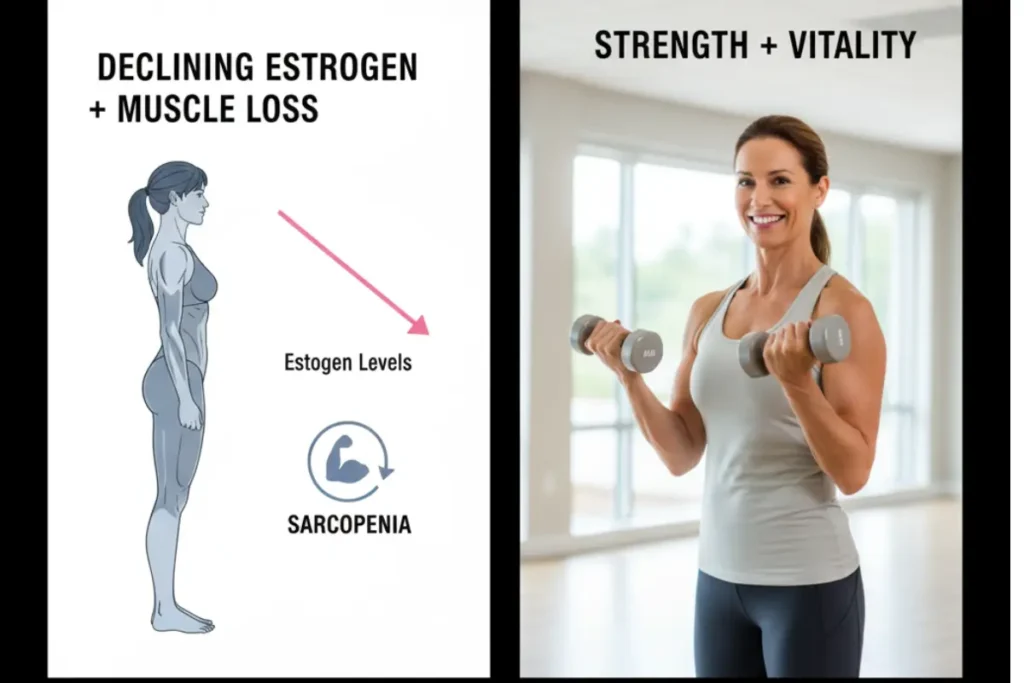
The Science of Sarcopenia and Hormones
After 40, your body undergoes significant physiological shifts that make protein essential, not optional.
The Dual Challenge: Hormones and Muscle Loss
Estrogen levels begin to decline during perimenopause and menopause, which can influence where your body stores fat (often shifting it to the abdomen). At the same time, sarcopenia—the gradual loss of muscle mass and strength—accelerates. Women can lose up to 1% of their muscle mass each year. Since muscle is a metabolically active tissue, less muscle means a slower resting metabolism. This makes weight gain easier and loss harder, even if your eating habits haven’t changed.
Protein: Your Metabolic Leverage
Protein fights back against these changes effectively:
- Thermic Effect of Food (TEF): Protein has the highest thermic effect of food (TEF), meaning your body uses more energy (calories) to digest it than it does for carbs or fats.
- Satiety & Appetite Control: Protein boosts hormones that make you feel full and reduces the “hunger hormone,” ghrelin. This natural appetite regulation is a game-changer for maintaining a healthy body mass index (BMI) without feeling deprived.
How Much Protein Do You Really Need for Weight Loss?
The outdated RDA (0.8g/kg) is the bare minimum to prevent deficiency, not the optimal amount for fat loss and muscle preservation.
For women over 40, evidence supports a higher intake. According to recent analyses, aiming for 1.2–1.5 g of protein per kilogram of measured body weight is ideal for preserving lean mass in a calorie deficit.
Why This Range?
This intake provides the amino acids necessary to maintain lean muscle, preventing the “skinny-fat” phenomenon and protecting your metabolic rate. It’s a crucial strategy for healthy ageing and managing blood pressure and blood sugar levels.
How to Calculate Your Protein Needs Easily
The simplest method is to use your current body weight. For weight loss after 40, aim for 1.2–1.5 g/kg (≈ 0.55–0.7 g/lb).
Quick chart:
| Body Weight | Protein Range (1.2–1.5 g/kg) | Approx. Grams per Meal (3 meals + 1 snack) |
|---|---|---|
| 50 kg (110 lbs) | 60–75 g/day | 15–20 g per meal + 10 g snack |
| 60 kg (132 lbs) | 72–90 g/day | 20–25 g per meal + 10 g snack |
| 70 kg (154 lbs) | 84–105 g/day | 25–30 g per meal + 10 g snack |
| 80 kg (176 lbs) | 96–120 g/day | 25–30 g per meal + 15 g snack |
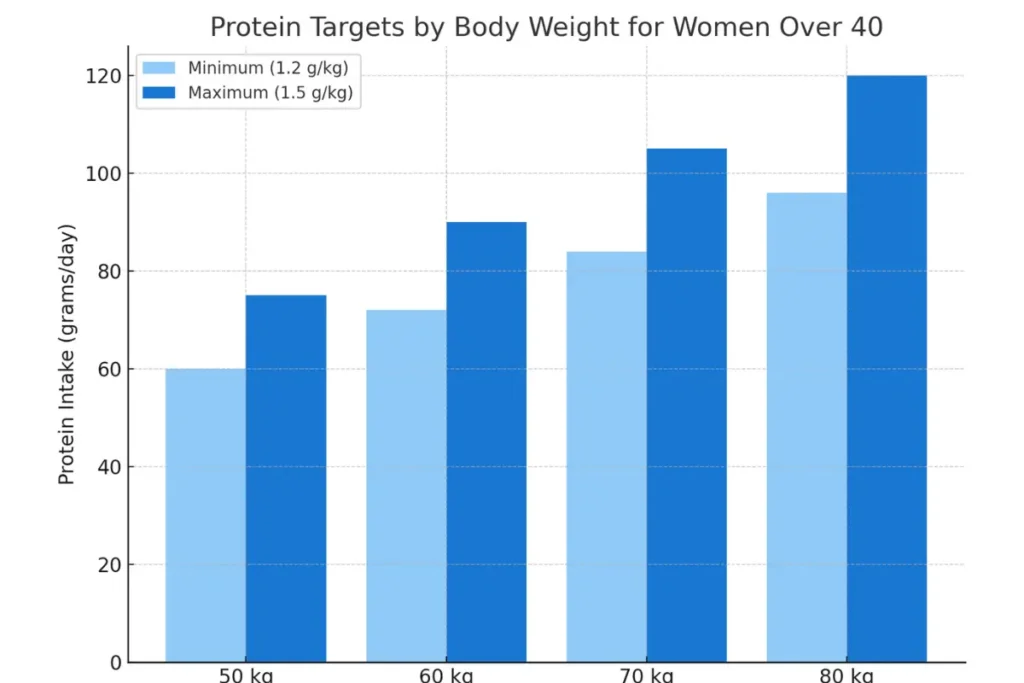
Tip: Spread protein evenly throughout the day.
One-day example for 65 kg (143 lbs), target 78–98 g:
- Breakfast: 25 g (2 eggs + Greek yoghurt)
- Lunch: 25 g (chicken breast + quinoa)
- Dinner: 25 g (salmon + veggies)
- Snack: 10–20 g (protein shake or hummus + edamame)
Best Times & Ways to Eat Protein
Protein at Breakfast: Why It Matters
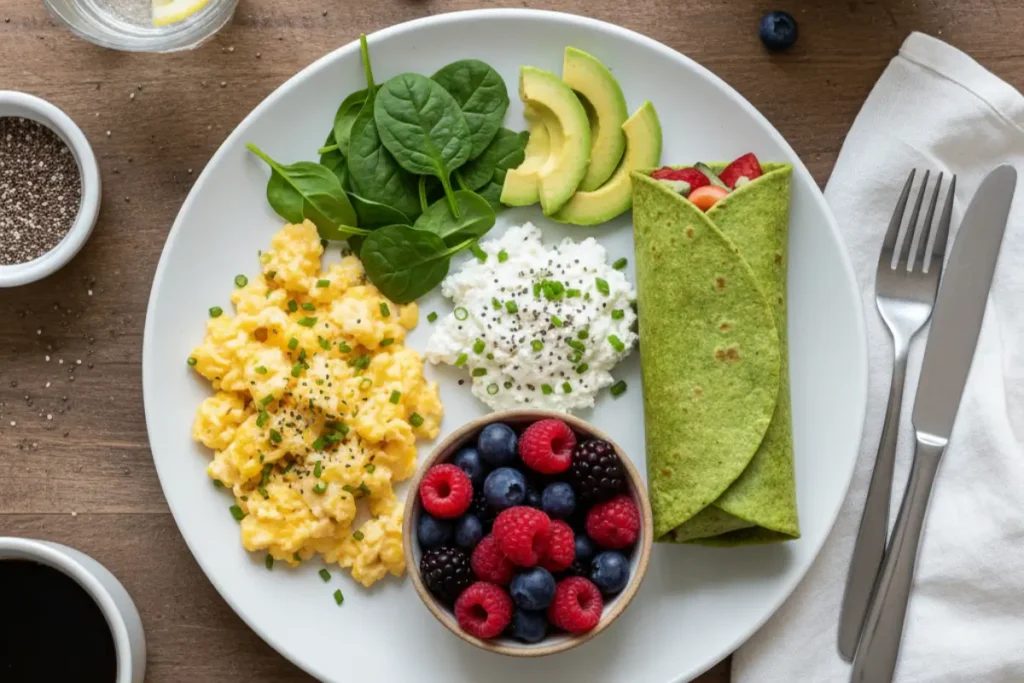
Starting with 20–30 g keeps you fuller longer, steadies blood sugar, and reduces mid-morning cravings.
Options (~25–30 g):
- 2 eggs + ½ cup cottage cheese + spinach wrap
- Greek yoghurt parfait with berries + chia
- Protein smoothie with whey/soy, almond butter, frozen fruit
Pre/Post-Workout Protein for Women Over 40
- Before exercise (1–2 hrs): 10–15 g (boiled egg, turkey slice, half a shake).
- After exercise (within 2 hrs): 20–30 g (chicken salad, salmon + sweet potato, or a protein smoothie).
Think of protein as your workout partner—it makes sure your effort pays off.
Evening Protein: Can It Help Overnight?
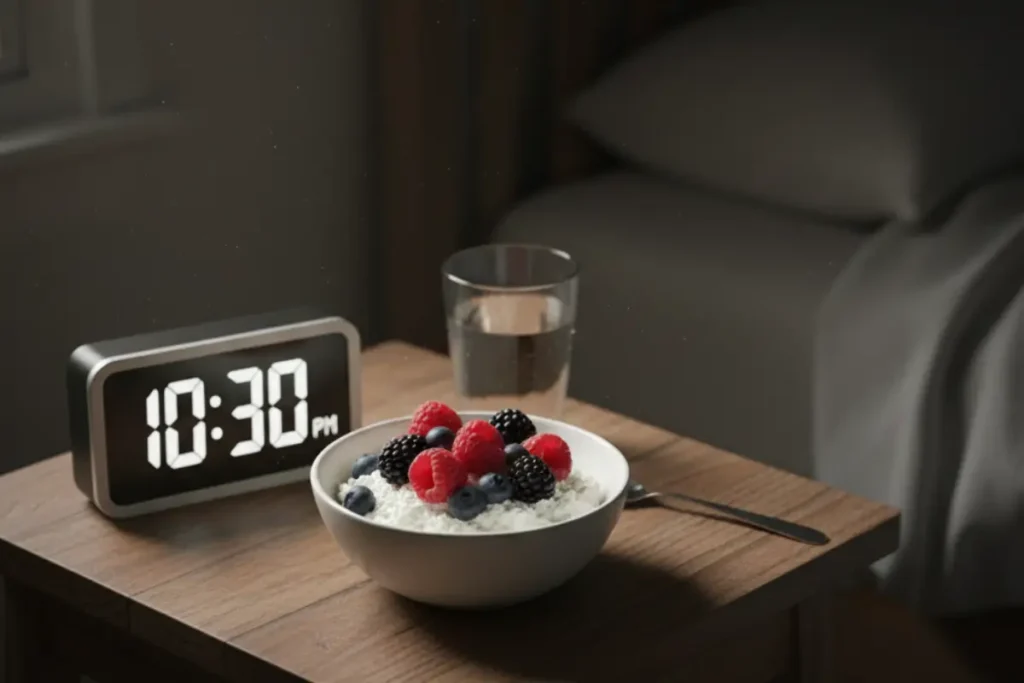
Protein before bed—especially casein-rich foods like cottage cheese—supports overnight recovery and reduces cravings.
Smart bedtime snacks (~15–20 g):
- Cottage cheese + berries
- Greek yogurt + walnuts
- Small protein shake
Best Protein Sources for Women Over 40
Animal-Based (Complete Proteins)
These sources contain all nine essential amino acids.
- Chicken & Turkey Breast: Lean, versatile, and high-protein.
- Salmon & Sardines: Excellent source of protein and anti-inflammatory omega-3s.
- Eggs: A perfect protein source, rich in nutrients.
- Greek Yoghurt & Cottage Cheese: High in protein and calcium, crucial for bone health.
- Lean Red Meat (e.g., Sirloin): A great source of iron and protein; choose lean cuts and consume in moderation to manage saturated fat intake.
Plant-Based Powerhouses
Plant proteins offer the bonus of fibre. Combine sources throughout the day to ensure a complete amino acid profile.
- Soy (Tofu, Tempeh, Edamame): A complete plant protein. Soy foods contain phytoestrogens, which have been associated with potential relief in some menopause symptoms in certain women.
- Lentils & Beans: Packed with protein and fiber for ultimate satiety.
- Quinoa: A rare complete plant-based grain.
- Nuts & Seeds: Perfect for snacks and adding protein to meals.
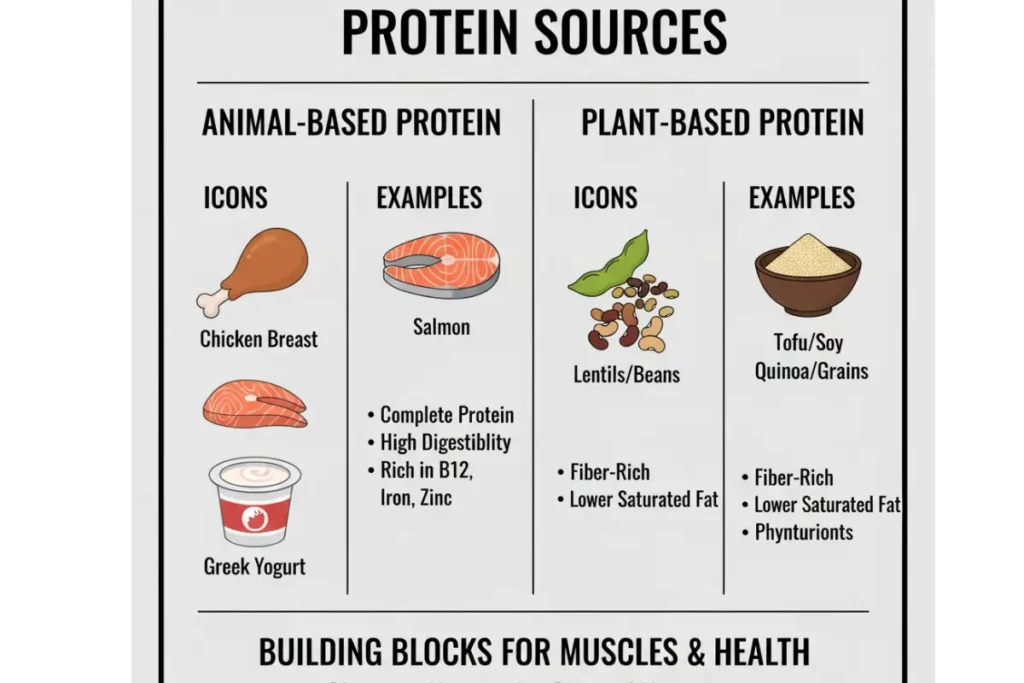
Protein in Real Life: Overcoming Common Challenges
Understanding the science is one thing; applying it to a busy life is another. Here’s how to make it work.
- Challenge: “I’m too busy to cook!”
- Solution: Embrace convenience. Keep hard-boiled eggs, pre-cooked grilled chicken strips, single-serve Greek yoghurts, canned tuna/salmon, and quality protein shakes on hand. A shake is better than skipping protein.
- Challenge: “I get strong cravings at night.”
- Solution: Prioritise your protein intake earlier in the day. A high-protein breakfast and lunch significantly reduce evening cravings. If a craving hits, opt for a high-protein snack like cottage cheese instead of carbs.
- Challenge: “I’m eating out with friends.”
- Solution: Scan the menu for grilled, baked, or roasted lean proteins (chicken, fish, seafood). Ask for sauces and dressings on the side. Start with a lean protein-based appetiser like shrimp cocktail.
Debunking Protein Myths & Understanding Risks
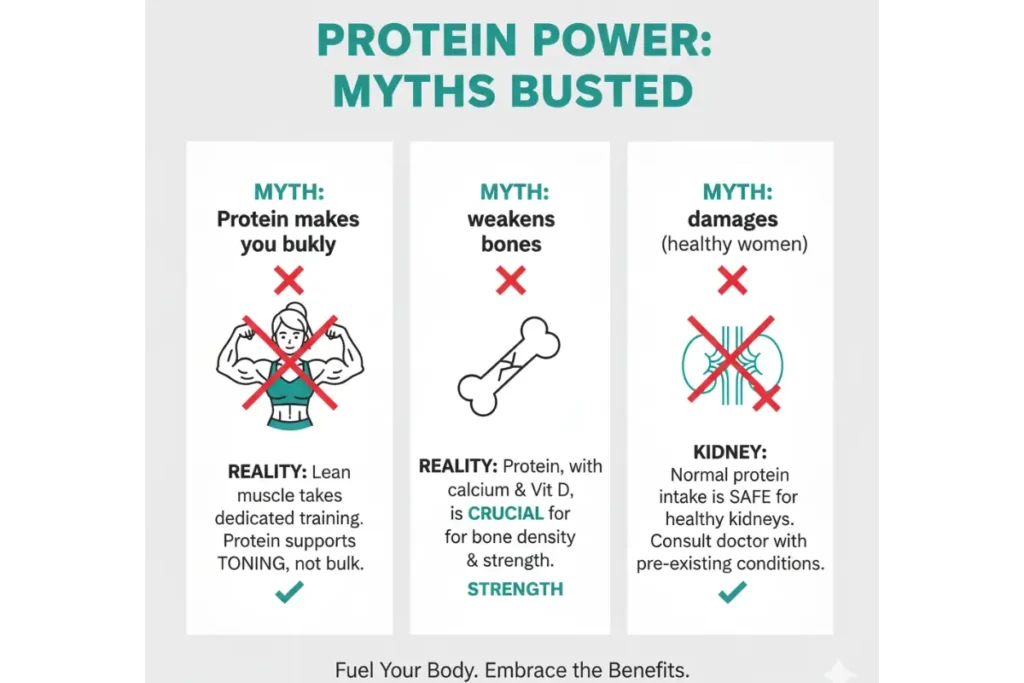
Myth 1: “Protein Damages Healthy Kidneys.”
Fact: For individuals with healthy kidneys, a higher protein intake is not harmful. According to the National Kidney Foundation, the caution applies primarily to those with pre-existing kidney disease or another specific health condition. Always stay hydrated.
Myth 2: “Protein Makes Women Bulky.”
Fact: Women have low testosterone levels. Protein supports building muscles that are toned and strong, not bulky. It helps create a defined physique, especially when paired with resistance training.
Myth 3: “Plant Protein is Inferior.”
Fact: While some plant proteins are “incomplete,” eating a varied diet throughout the day (e.g., beans and rice) provides all essential amino acids. Soy is a complete protein.
The Winning Combo: Protein + Resistance Training
Protein alone aids weight loss, but pairing it with the right exercise creates a powerful synergy for transforming your body after 40.
Strength Training: Non-Negotiable for Metabolic Health

Strength work counters sarcopenia and is critical for preserving independence. Resistance training signals your body to hold onto precious muscle, which keeps your metabolism high. Multiple studies confirm that the combination of adequate protein and resistance training preserves lean mass far more effectively than either strategy alone.
How Protein Supports Your Workouts
Protein provides the amino acids needed to repair the micro-tears in muscle fibres created during exercise, making them stronger. This process reduces soreness and speeds recovery, supporting long-term consistency.
A Simple Beginner-Friendly Routine (2- 3x/week)
- Bodyweight Squats
- Push-ups (on knees or against a wall)
- Glute Bridges
- Dumbbell Rows
- Plank Hold (20-40 seconds)
- Pair your workout with 20-30g of protein within 2 hours for optimal recovery and muscle growth.
Special Considerations: Protein Needs for Older Adults with Health Conditions
For older adults managing a specific health condition, optimising their amount of protein intake becomes even more critical. While a high-protein diet is generally safe and beneficial for most, certain situations warrant a more tailored approach. If you have any ongoing health issues, consulting a registered dietitian is the best way to create a plan that supports your goals and manages your condition.
Protein, Blood Sugar, and Type 2 Diabetes
For those managing type 2 diabetes, protein is a powerful tool. Unlike carbohydrates, dietary protein has a minimal impact on blood glucose levels. Including a source of protein with every meal and snack can help slow the absorption of sugars, leading to more stable blood sugar throughout the day. Furthermore, studies show that combining adequate dietary protein with resistance training helps build and preserve lean body mass, which improves insulin sensitivity. This makes it easier to manage your weight and body mass index (BMI).
Preserving Precious Muscle Tissue
The natural decline of muscle tissue with age is a primary concern. For older adults, the goal isn’t just weight loss—it’s fat loss while maintaining muscle. This is where protein and exercise are non-negotiable partners. Resistance exercise provides the stimulus, and protein provides the building blocks—the essential amino acids—required for repair and growth. Without sufficient protein, your body cannot effectively maintain muscle, even if you are strength training.
Navigating Protein Sources with Specific Conditions
- Kidney Disease: If you have an existing kidney condition, very high protein intake may increase the risk of complications. It is essential to work with your healthcare team to determine a safe amount of protein for you.
- Heart Health: When increasing protein, be mindful of sources. Balance animal proteins (choosing lean cuts to limit saturated fat) with plant-based proteins like lentils and beans, which also provide heart-healthy fibre and healthy fats.
Practical Adaptation: Short-Term and Long-Term
- Short-Term: If you’re new to increasing protein, do it gradually to allow your digestive system to adjust. Start by adding a serving of Greek yoghurt or a scoop of protein powder to a smoothie.
- Long-Term: View protein intake as a key pillar of your long-term health strategy. Consistent strength training coupled with adequate protein is one of the most effective ways to support mobility, independence, and metabolic health as you age.
The Bottom Line: For older adults, especially those with conditions like type 2 diabetes, a protein-rich diet is not just about weight loss—it’s about functional health. By focusing on preserving lean body mass through dietary protein and resistance exercise, you invest in your strength and vitality for years to come. Always personalise your approach with guidance from a healthcare professional.
Conclusion & Your Next Steps
Increasing your protein intake is one of the most effective strategies for managing your weight and health after 40. It’s a shift toward nourishing your body to support the natural changes it’s experiencing.
Your actionable plan:
- Calculate Your Target: Use the chart above to find your daily protein goal.
- Prioritise Protein at Every Meal: Use the visual guide to portion your plates.
- Start Strength Training: Begin with 2 short sessions per week.
- Plan for Obstacles: Use the real-life tips to stay on track.
To make this effortless, I’ve created two free tools for you:
- Precise Protein Calculator: Get your exact daily target.
- 1-Day High-Protein Meal Plan: A practical guide to see what this looks like.
[Click Here to Download Your Free Protein Calculator & Meal Planner]
If you’d like a bigger-picture plan that goes beyond protein, take a look at Diet & Nutrition Tips for Women Over 40—it covers smart carbs, fiber, healthy fats, hydration, and micronutrients that make your protein strategy even more effective. It’s the perfect next step to round out your routine.
Start with one change today. These consistent steps are the key to unlocking sustainable weight loss and feeling stronger and more energised.
FAQs About Protein Intake for Weight Loss After 40
Most research supports 1.2–1.5 grams of protein per kilogram of body weight per day (about 0.55–0.7 grams per pound). For example, a 65 kg (143 lb) woman should aim for 78–98 grams daily. Spreading this evenly across meals (20–30 g per meal) helps preserve muscle, keep metabolism active, and reduce hunger.
Protein doesn’t directly burn belly fat, but it helps indirectly by increasing fullness, boosting metabolism, preserving muscle during weight loss, and reducing visceral fat when paired with exercise and balanced calorie intake.
For most healthy women, yes. For a 70–80 kg woman, 150 g falls within the 1.5–2 g/kg safe range. It is generally safe as long as kidney function is healthy and hydration is adequate. Most women do best aiming for 80–110 g daily, but up to 150 g can be safe if it fits their calorie needs.
The best shake depends on your needs. Whey protein is fast-digesting and great post-workout, casein protein digests slowly and is ideal at night, and plant-based options like soy, pea, or hemp are excellent for those who prefer dairy-free. Look for shakes with at least 20–25 g protein, low sugar, and a short ingredient list.